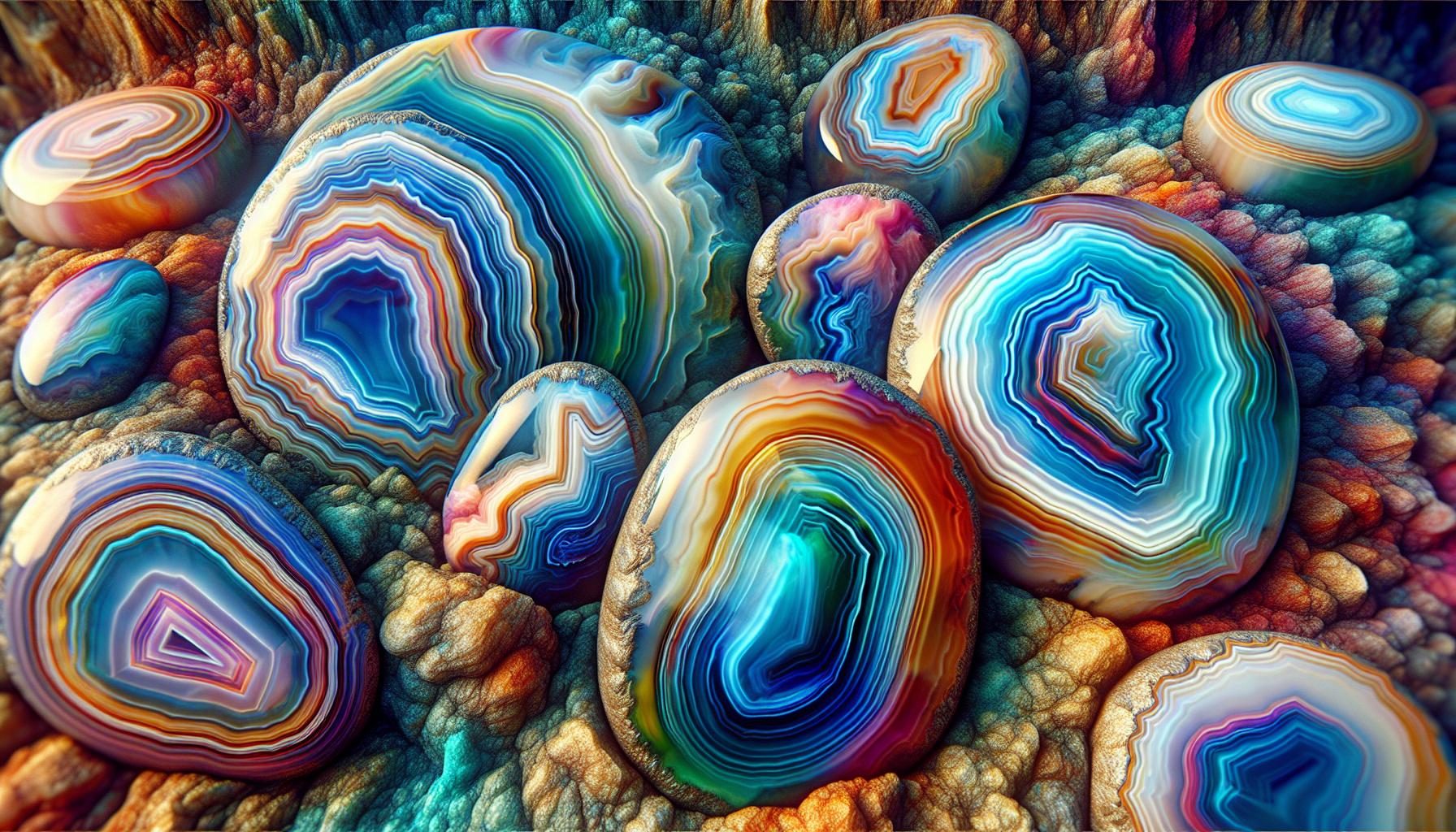Ever stumbled upon a colorful, banded stone and wondered if it’s an agate?
You’re not alone. Agates are a fascinating variety of chalcedony that boasts a mesmerizing array of patterns and colors, making them a favorite among collectors and hobbyists alike.
Knowing how to identify an agate can elevate your rock hunting game or simply satisfy your curiosity about the treasures beneath your feet. With a few key features to look out for, you’ll soon be spotting these natural beauties with confidence.
From recognizing the signature bands to understanding agate’s unique hardness and translucency, we’ll guide you through the basics of agate identification.
Get ready to discover the world of these semiprecious stones and what sets them apart from other minerals.
To identify agate, observe for distinctive banded patterns and a range of colors. Agates are typically translucent, have a white streak, and rank about 7 on the Mohs hardness scale. They exhibit a vitreous luster and are not magnetic.
How to Identify Agate Through Testing
When you’re out in the field or examining potential agate finds, there are several tests you can perform to confirm the identity of a stone. These tests range from simple visual inspections to more detailed examinations.
Visual Inspection
Before you dive into more complex testing, start with a thorough visual inspection. Look for distinct banding patterns which are the hallmark of agate. You should also note the colors and translucency as agates can range from nearly transparent to opaque. Examine the stone closely for a waxy luster, another common characteristic of agate.
The Streak Test
The streak test can help you determine the color of the agate’s powder, which is helpful for identification. Take the stone and rub it across an unglazed porcelain tile; agate should leave no streak. If your specimen leaves a streak, it’s likely not an agate.
Magnet Test
While agates aren’t magnetic, the presence of certain minerals within the stone could cause a slight magnetic reaction. Test your stone with a magnet to rule out other types of minerals that are commonly mistaken for agate.
Hardness Test
Agates rank around a 7 on the Mohs scale of hardness. Perform a scratch test using different materials to assess where the stone falls on the scale. Start with a steel file (which ranks about 6.5) and see if it can scratch the surface. If your specimen withstands a scratch from the file, it indicates comparative hardness characteristic of agate.
Birefringence Test
Agates exhibit a physical property known as birefringence, visible when light passes through the mineral. By looking at your specimen under polarized light or using a specialized tool, you may see double refraction of the light within the stone, indicating it’s likely an agate.
Checking the Diaphaneity
Assessing the diaphaneity, or the degree of transparency, is a simpler visual test. Agates can be transparent, translucent, or opaque. Holding the stone against a light source can help you evaluate its level of diaphaneity.
Single or Double Refraction
A distinct characteristic of agate is its double refraction. Unlike minerals with single refraction where light passes straight through, agates cause light to split into two paths, which can be observed through specific gemological equipment.
Refractive Index Test
Agate has a refractive index between 1.530 and 1.540. This test requires specialized equipment but it can firmly establish if your stone is an agate based on how it bends light.
Finding the Specific Gravity
The specific gravity of agate ranges from 2.58 to 2.64. You can calculate this by weighing the stone in air and then weighing it suspended in water. This test helps by comparing the density of your specimen to that of authentic agate.
Identifying Agates in the Field
Be on the lookout for rocks that show a conchoidal fracture and those with a fine-grained texture. Knowing the typical environments where agates form, such as volcanic regions or areas with past volcanic activity, can also guide you.
Recognizing Potential Agate Rocks
In the field, potential agate rocks might not always be immediately identifiable. Look for a smooth, varnished appearance which could indicate the presence of agate beneath the surface. Some agates may still be encased in their original host rock, which can mask their banding until cut and polished.
Physical Characteristics of Agate

When you’re on the hunt for agates, knowing their physical traits can be your ticket to success. Agates typically have a smooth, waxy luster, and they often show layers or bands of color. These distinctive bands may appear as curved or concentric lines on the stone’s surface, instantly grabbing your attention.
Agate formation is a result of silica from groundwater permeating porous rocks. Over time, it accumulates in layers, leading to the banded structure that’s central to its identity. Agates are usually associated with volcanic rocks and can often be found as nodules in volcanic lavas.
Remember, they aren’t usually transparent but rather translucent to opaque, meaning you’ll notice light passing through the thinner sections of the stone. A reliable way to spot an agate includes its weight. Agates are denser than they look because of the silica content. They feel heavier than usual rocks of the same size.
Their hardness also stands out. On the Mohs scale, agates rate between 6.5 and 7. This makes them sufficiently hard to scratch glass. While exploring, carry a glass tile for a quick scratch test to gauge hardness.
Bearing in mind these physical characteristics, your quest for agates should prove less challenging. Keep your eyes peeled for these signature features and apply the tests previously mentioned for an accurate identification.
How Are Agate Formed?
Agates captivate collectors and gem enthusiasts due to their unique and stunning patterns, which are the result of their intricate formation process. Understanding this geological journey not only aids in identification but also deepens your appreciation for each agate’s individual story.
Agate formation begins as a void in volcanic rock fills with silica-rich water. Over time, layers of silica deposit on the walls of these cavities, gradually crystallizing to form concentric bands. The variety of colors and patterns in agate comes from impurities and trace minerals within these layers.
Key points in the formation process:
- Silica Saturation: As groundwater permeates through volcanic rocks, it becomes saturated with silica, which is essential for agate formation.
- Temperature and Pressure: Both play a vital role. Cool conditions and moderate pressure favor the slow crystallization necessary for the development of the agate’s signature bands.
- Presence of Minerals: Iron, chromium, manganese, and other minerals can become part of the silica deposits, offering a spectrum of colors and designs unique to each agate.
Each layer records a footprint of the environmental conditions at the time of its deposition. This layered structure is not merely aesthetic; it speaks of historical shifts in mineral content, temperature fluctuations, and changes in water chemistry. Understanding these formation patterns helps you identify authentic agates, particularly when you’re evaluating banding and color, which reflect the specifics of their genesis.
Preparation for Agate Hunting
Before you head out on your agate hunting adventure, it’s essential to prepare properly. This means getting together the right tools and considering your safety to ensure a successful and enjoyable trip. Whether you’re exploring a beach, desert, or riverbed, having the necessary equipment and knowledge can make all the difference in finding those precious stones.
Gathering the Right Tools
To maximize your chances of spotting and retrieving agates, you’ll need a few key tools:
- Rock Hammer: This is crucial for gently breaking rocks or chipping off samples.
- Chisel: To pry agates out of surrounding rocks, a sturdy chisel is indispensable.
- Safety Goggles: Chipping rocks can send small fragments flying, so protect your eyes.
- Gloves: Durable gloves can protect your hands from sharp edges and rough surfaces.
- Magnifying Glass: A magnifying glass helps you take a closer look at potential agates.
- Field Guide: Carry a guide to help you identify different types of rocks and minerals.
- Bucket or Bag: You’ll need something to carry your finds.
Remember, the right tools will not only aid in identifying agates but also in safely recovering them without damage. It’s about striking a balance between being well-equipped and mobile.
Safety Considerations
When hunting for agates, you mustn’t overlook your safety. Here are some precautionary measures to keep in mind:
- Wear Sturdy Footwear: Rugged terrain requires boots or shoes with good grip and ankle support.
- Check the Weather: Be aware of local weather conditions and plan your trip accordingly.
- Stay Hydrated: Always bring plenty of water, especially if you’re searching in hot, dry areas.
- Sun Protection: Sunblock, a hat, and long sleeves will help prevent sunburn.
- First Aid Kit: Always have a basic first aid kit on hand for emergencies.
Also, it’s wise to inform someone about your agate hunting location and expected return time. Safety is paramount; don’t take unnecessary risks for the sake of finding stones.
By ensuring you’ve got the right tools and have considered all safety aspects, you’ll be ready to embark on your agate hunting journey with confidence. Keep in mind that patience and persistence often yield the best results when searching for these natural treasures.
Handling and Care of Found Agate
Cleaning Agates
Once you’ve successfully identified and collected agates, the next step is to clean them properly to showcase their natural beauty. Begin by washing your agates in warm, soapy water to remove any dirt or debris. If you encounter stubborn grime, soft-bristled brushes or toothbrushes work wonders without scratching the stones.
For deeper cleaning, consider soaking the agates in white vinegar or iron out solution to dissolve any iron oxide staining. Remember, though, that agates are relatively porous, so don’t leave them soaking for too long—a few hours should suffice. After soaking, rinse the stones thoroughly to eliminate any residue of the cleaning agent.
Storing Agates
Proper storage is essential to protect your agates from damage. Here are some tips:
- Wrap individual agates in soft cloth or place them in fabric-lined boxes to prevent scratches.
- Avoid storing multiple agates together without protection, as they can chip or scratch each other.
- Keep agates away from direct sunlight and extreme temperature changes, which can cause them to crack.
When displaying your agates, consider placing them on a stable shelf or in a display case to avoid accidental drops. With these simple steps, your beautiful finds will remain intact and as striking as the day you found them.
Conclusion: Confirming Real Agate
You’ve gained the knowledge to identify and care for agates, transforming a simple rock hunt into a rewarding hobby.
Remember to gently clean your treasures and store them safely to preserve their natural beauty. Showcase your agates with pride, knowing you’ve mastered the art of spotting these geological gems. Keep exploring and trust your instincts; your next discovery is just around the corner.
Happy hunting!







